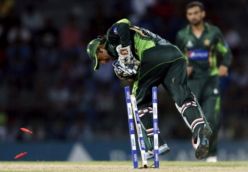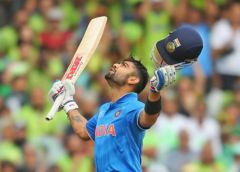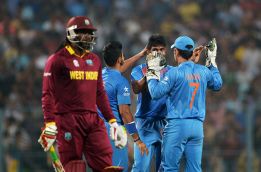
Ever since its advent in the 18th century when matches were played for over five days, the game of cricket, just like Darwin's theory of evolution, has come a long way by adapting to its surroundings over the years.
Also read: Why the Kiwis could shock MSD & Co in today's tie
Evolution is a fairly natural phenomenon, and similar to a corrupt politician, it's omnipresent. Darwin's theory elaborates on 'beneficial mutations' passed on from one generation to another, aiding the formation of an entirely new organism. T20 cricket is one such mutation.
In the 21st century where time is of essence for one and all, the shortest format has managed to provide the much-needed adrenaline and highly-sought entertainment while demanding just three hours from cricket-crazed fans.
A format where youngsters exceed expectations and senior players learn their limits. A platform where batsmen are no longer afraid of being judged for their shots. The orthodox shots have made way for eye-catching switch-hits, while respecting the bowler or good deliveries is no longer an option.
One cannot question evolution, one simply moves on. The debate whether T20 format is good or bad for the game of cricket still continues, but the latest changes in the sport have undoubtedly captured the imagination of the masses. "Without greatness, a game shrivels. Without an audience, it dies," the wise Peter Roebuck sums it up in the best possible manner.
The T20 fervour is set to take centrestage once again as the coveted ICC tournament comes to India to enthrall cricket fanatics with the glitz, glamour and some slam-bang 20-over action. Here's a look at five typical T20 shots that could dictate this year's tournament:
The cheeky scoop
Originally known as the Marillier shot, the ramp or scoop has become one of the most effective and frequently-employed shot in limited-overs cricket. The shot was pioneered by Zimbabwean batsman Dougie Marillier whose ability to move across and hoick the ball over short fine leg guided his side to a famous win over India in 2002.
It was further perfected by Sri Lankan batting star Tillakaratne Dilshan who used the shot to full effect during the 2009 ICC World T20. Dilshan played the shot right over the head of the wicket-keeper unlike the Marillier shot that was played towards the side. Soon, the shot was being labelled as the 'Dilscoop' following Dilshan's exploits on the field.
Due to the favourable field settings, the shot is often used in the later stages of limited-over games. The region behind the wicket-keeper tends to be more lightly patrolled by fielders, so the risk-benefit status of the shot is relatively more favourable to the batsman.
Inside-out shot
The modern-era of cricket has witnessed a rapid rise in the use of the inside-out shot among the ever-evolving players. In limited-overs cricket where the pressure of scoring runs at a brisk pace decides the fate of the match, the inside-out shot becomes furthermore important.
While employing this shot, the batsman skips down the wicket and uses the room to lob the ball over the cover region for an easy boundary. The field restrictions inside the circle open up a lot of scoring options over the cover region. Despite being effective in limited-overs cricket, the shot is quite difficult to play.
A batsman, if he fails to reach to the pitch of the ball, remains exposed to the threat of being stumped. Plus, the lack of timing and elevation in the shot can lead to an easy wicket for the opposition. Hashim Amla, AB de Villiers and Glenn Maxwell have mastered this shot over the years. Among Indian batsmen, Virat Kohli and Suresh Raina are often seen using this shot against spinners and seamers alike.
Switch-hit
Another innovative and eye-catching shot that seems to highlight the evolution of modern-day cricket is undoubtedly the switch-hit. It allows batsmen to make full use of the field restrictions on the off side while switching their grip and stance from right-handed to a left-handed style and vice versa.
Kevin Pietersen has been associated with this shot for quite some time now. However, it has also been used effectively by the Aussie batting stars David Warner and Glenn Maxwell. For South Africa, the swashbuckling AB de Villiers plays the shot with perfection, especially against the fast bowlers.
Reverse sweep
In limited-overs cricket, where majority of the things work in favour of the batsmen including the field placement, the hard-hitting batting stars have thoroughly enjoyed their domination against the opposition bowlers. The reverse sweep has majorly contributed to the success of batsmen in limited overs.
The shot, which requires a lot of practice, is often used by batsmen to disturb the line and length of the opposition bowler. By a sudden change in grip from right-hand to a left-hand style and vice versa, the batsmen are often seen sweeping the ball and beating the in-field to steal a cheeky boundary. Glenn Maxwell and AB de Villiers are some of the best players of the reverse sweep.
Helicopter shot
Arguably one of the most innovative strokes in modern-day cricket, the helicopter shot is purely entertaining to watch. Indian captain MS Dhoni has been long associated with the helicopter shot, which is being used by other batsmen now.
In this shot, the batsman hangs back in the crease and uses his bottom hand to generate power while completing his follow through by making his bat swirl in a helicopter-like swing. The wrist work and strength of the batsman is key to successfully playing this shot.








![BJP's Kapil Mishra recreates Shankar Mahadevan’s ‘Breathless’ song to highlight Delhi pollution [WATCH] BJP's Kapil Mishra recreates Shankar Mahadevan’s ‘Breathless’ song to highlight Delhi pollution [WATCH]](https://images.catchnews.com/upload/2022/11/03/kapil-mishra_240884_300x172.png)

![Anupam Kher shares pictures of his toned body on 67th birthday [MUST SEE] Anupam Kher shares pictures of his toned body on 67th birthday [MUST SEE]](https://images.catchnews.com/upload/2022/03/07/Anupam_kher_231145_300x172.jpg)






